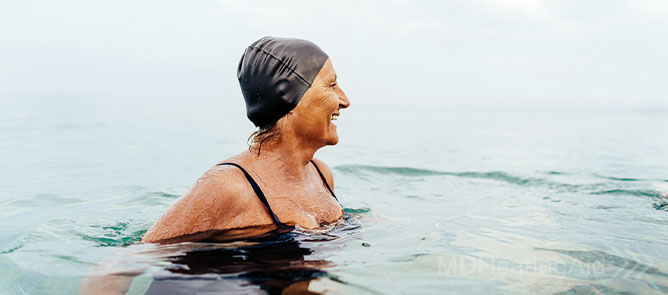Your body loves water. After all, the human body is about 60% water, so it’s no surprise that it’s essential.
But not all parts of the body handle water so well. For example, your fingers and toes can get wrinkly if submerged in water too long. When water gets up your nose, you can feel a lot of pain. Your ears also dislike water. In fact, if you get water in your ear canal, you might end with an ear infection.
Most times, water drains from your ear when you move around. If it doesn’t, you might need to try different methods to get the water out before it causes a problem.
How Does Water Get in Your Ear?
Swimming and bathing are the most common ways you get water in your ear canal. You can also have moisture caught in your ear from sweaty earbuds or from steam as you sit in a sauna or hot tub.
What Does Water in the Ear Feel Like?
Water in your ear can create a strange, tickling sensation. This feeling often travels down your jawline and into your neck. You might feel the urge to shake your head to make the sensation go away.
Your ear can ache if it is more sensitive, and you may feel pressure in your ear. A clogged ear from earwax or sinus infections can create ear pressure as well, so it’s important to know what condition you may have.
Muffled hearing is another common feeling when you have water in the ear. Muffled hearing may feel like there’s something covering your ears, and you may strain to hear sounds. You don’t hear as well as you did before.
What to Know About Water in Your Ear and Ear Infections
The longer you leave trapped water in your ear, the more likely you are to develop an infection.
Called swimmer’s ear, or otitis externa, the infection can lead to symptoms like:
- Pain that can become severe.
- Itchiness in your ear.
- Muffled hearing.
- Fluid or pus coming out of your ear.
- Fever or dizziness.
- Redness and warmth inside and on the outside of your ear.
Swimmer’s ear is usually a bacterial infection but can also be from a virus or fungus instead. This infection differs from another common ear infection called otitis media, or middle ear infection, in what causes it and who can get it.
While trapped water most often causes swimmer’s ear, colds and other illnesses often cause otitis media. Anyone can get swimmer’s ear, but children are more likely to get otitis media.
How to Get Water Out of Your Ear
If you get water in your ear, you want to get it out as soon as you can. Here are some ways to help.
1. Tilt Your Head
For this method, all you need to do is lean to one side and make sure your affected ear points toward the ground.
Keep your head tilted for several minutes to let any trapped water move down and out of the ear canal. Use a soft, clean washcloth to wipe off any water that runs down the outside of your ear.
If you prefer, you can lie on your side with your head propped on a pillow. Try to keep your ear from pressing into the pillow, and place a small washcloth between the pillow and your ear to absorb any water.
2. Jiggle Your Earlobe
Another method to get water out of your ear is to jiggle or pull on your earlobe. Make sure you tilt your head to the side as you move the earlobe back and forth.
This rapid but gentle motion should move the water out of the ear canal. You can use a clean cloth to absorb the liquid.
3. Yawn or Chew Gum
This method works in combination with #2 above. First, yawn and try to stretch your jaw, moving your jaw from side to side if possible. Instead of yawning, you could chew gum to help move your jaw.
Then, tilt your head to the side and pull or jiggle the earlobe to help get the trapped water out.
4. Use a Hair Dryer
You can also try using a hair dryer on a low-heat setting. Water doesn’t evaporate as fast in cold, wet, or humid climates, so a little heat can sometimes do the trick.
Hold the hair dryer at least one foot from your ear and slowly move it from side to side. You can jiggle the earlobe at the same time to help the warm, dry air get into the ear canal.
5. Use the Valsalva Maneuver
The Valsalva maneuver is another way to help water leave your ear. It works to even out the pressure in the middle ear, which may help push water toward the outer part of your ear.
To use this method, use your thumb and index finger to pinch your nostrils closed. Then, close your mouth and breathe out for a few seconds. Your cheeks may puff out a bit. To protect your delicate eardrum, don’t exhale too hard.
Stop exhaling, unpinch your nose, and tilt your head to the side. As you breathe normally, move your jaw from side to side and pull on your earlobe.
6. Create an Ear Vacuum
You can also create a vacuum using your hands. Here, you create a shallow cup shape with your palm and place it against your ear. You want to cover your ear to create a seal, so let your fingers follow the shape of your head, almost cradling it.
Tilt your head to the side. Push your hand toward your ear and quickly pull it away, but try to keep the seal covering your ear. Repeat this back-and-forth motion several times to create a vacuum. This vacuum may help to pull water out of your ear. Remember to keep your ear pointing toward the ground to let the water drain.
7. Make Vinegar and Rubbing Alcohol Drops
Vinegar and rubbing alcohol ear drops can help remove water and get rid of bacteria. To make these drops, get a clean bottle with a sterile dropper. Pour equal parts rubbing alcohol and vinegar into the bottle and give the liquid a gentle shake to mix it up.
Add three or four drops to your ear using the sterile dropper and massage the outside of your ear to help the ear drops move into the ear canal. Count to 30 and turn your head to let the liquid drain.
If you have a punctured eardrum, tubes in your ears, or a diagnosed outer ear infection, don’t use this method.
8. Use Over-the-Counter Ear Drops
You could also buy over-the-counter (OTC) ear drops. Some ear drops help absorb trapped water, and some help dissolve earwax that may trap the water in the first place.
Typically, OTC ear drops that dissolve earwax contain carbamide peroxide or hydrogen peroxide. OTC ear drops for trapped water contain acetic acid and alcohol.
Whichever drops you use, follow the directions on the side of the package. You want to tilt your head or lie on your side and remain still for a few minutes. Then, tilt your head in the opposite direction to let the liquid drain.
Speak to your doctor if you have a punctured eardrum, tubes in your ears, or a diagnosed outer ear infection. They may recommend that you avoid this method.
How to Get Water Out of Your Ear: What NOT to Do
When you have water in your ear, the last thing you want to do is make the problem worse. You may want to put something in your ear, but you shouldn't as that can cause new problems.
Don’t use cotton swabs, fingers, fingernails, or any other objects. Not only might you push earwax and any trapped water deep into your ear canal, but you can also scratch the delicate skin inside your ear, introduce bacteria, or even harm your eardrum.
Can You Prevent Water from Getting in Your Ear?
Yes and no. You can take preventive steps to keep water out, but sometimes, you might still get a bit of water in your ear. That’s where the eight steps above can help.
The following ways can reduce the chance of getting water or moisture trapped in your ear.
- Use a swim cap or ear plugs when you go swimming.
- Don’t leave earbuds in your ears for too long.
- Wipe a towel across the outside of your ear to absorb water after a shower.
When to See a Doctor
Ear health is important at any age. If you can’t get trapped water out of your ear or if your symptoms worsen, make an appointment with your primary care doctor. You might have an ear infection and need antibiotics or other prescription medication.
Apart from checking your hearing with an online hearing test or one at a hearing clinic, you should go for a health check if you have ringing in the ears, intense pain, or full or partial hearing loss. These symptoms might point to another health condition.
Your primary care doctor might recommend that you see an audiologist or an otolaryngologist, also known as an ear, nose, and throat (ENT) doctor. These specialists can help you find out what’s causing your lingering hearing problems.
Final Thoughts
From tickling sensations to pain that won’t go away, water in the ear can be more than a nuisance. The good news is that now you know some of the best ways to get water out of your ear.
If you get an ear infection from trapped water and it keeps coming back, you could end up with permanent hearing loss. But this hearing loss doesn’t need to take over your life. Hearing aids from top hearing aid brands can help improve your hearing and regain your quality of life.
At MDHearing, we offer high-quality hearing aids at affordable prices. Our FDA-registered models range from $399 per pair to $999 per pair, far less than other name brands. Our U.S. based team of specialists is always available to answer your questions about your hearing concerns or work with you to find the best hearing aids for your needs. Get started with a free online hearing test.
Get started with a quick, free, and easy online hearing test.
TAKE ONLINE HEARING TEST


